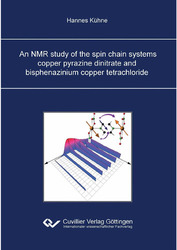| Departments | |
|---|---|
| Book Series (96) |
1378
|
| Nachhaltigkeit |
3
|
| Gesundheitswesen |
1
|
| Humanities |
2364
|
| Natural Sciences |
5406
|
| Mathematics | 229 |
| Informatics | 319 |
| Physics | 980 |
| Chemistry | 1363 |
| Geosciences | 131 |
| Human medicine | 243 |
| Stomatology | 10 |
| Veterinary medicine | 108 |
| Pharmacy | 147 |
| Biology | 835 |
| Biochemistry, molecular biology, gene technology | 121 |
| Biophysics | 25 |
| Domestic and nutritional science | 45 |
| Agricultural science | 1004 |
| Forest science | 201 |
| Horticultural science | 20 |
| Environmental research, ecology and landscape conservation | 148 |
| Engineering |
1793
|
| Common |
98
|
|
Leitlinien Unfallchirurgie
5. Auflage bestellen |
|
Advanced Search
An NMR study of the spin chain systems copper pyrazine dinitrate and bisphenazinium copper tetrachloride (English shop)
Hannes Kühne (Author)Preview
Table of Contents, Datei (50 KB)
Extract, Datei (68 KB)
This thesis presents a comprehensive nuclear magnetic resonance (NMR) examination of the magnetic field-driven quantum phase transitions (QPTs) in the metalorganic spin chain compounds copper pyrazine dinitrate (CuPzN) and bisphenazinium copper tetrachloride (PhnCuCl). Due to their relatively small magnetic exchange interaction energy J, the full magnetic phase diagrams of both sample systems could be accessed experimentally, i.e. in the parameter range from the low- (B « Bc) to the high-field limit (B » Bc) and temperatures from the quantum regime (kBT « J) up to the classical regime (kBT » J). CuPzN is a well-characterized model system for the isotropic, S =1/2 antiferromagnetic Heisenberg chain (AFHC). A study of the 13C and 14N NMR frequency shifts allows to determine selected magnetic hyperfine coupling tensors, distributions of magnetic moments, and gradients of the crystal electric field within the unit cell. With these results, a well-controlled adjustment of the nuclear sensitivity to the different components of the electronic spin fluctuations on the chain can be realized. The 13C 1/T1 relaxation rates, probing the dynamical structure factor at very low frequencies, reveal a linear temperature dependence in the low-field phase, an exponential decrease in the gapped high-field phase, and a well-defined, field-driven
maximum slightly below the quantum critical point Bc = 14.6 T. In the regime of the phase transition, a power-law decay of the rates with a field-dependent exponent is found. The experimental observations are very successfully compared with predictions from both numerical (quantum Monte Carlo) and analytical (conformal field theory) theoretical approaches. In particular, the downshift of the field-driven maximum is shown to be caused by essential spin-spin interactions. It is intimately connected to the field dependence of the spinon velocity and the Luttinger liquid exponent K, and therefore can be seen as a direct signature of the Luttinger liquid phase. The study of the anisotropic 14N NMR observables in the low-field regime allows to further refine the findings about the distribution of spin moments in the unit cell, and to exclude the presence of fluctuations of the electric field gradient at the nuclear Larmor frequency for temperatures in the quantum regime. The temperature dependence of the low-field 14N-1/T1 rates fully reproduces the corresponding 13C-1/T1 data, and therefore confirms the carbon nuclei as suitable probes for the electronic
spin dynamics. CuPzN is the first model system which shows this good agreement with theoretical predictions for the S =1/2 AFHC model in all characteristics. Therefore, some of the results presented in this thesis can be seen as a reference, against which the results obtained from other compounds can be tested. PhnCuCl is an only recently synthesized metalorganic low-dimensional spin system. In order to determine the magnetic interaction scheme in this compound, a characterization by means of magnetization and specific heat measurements in a broad range of magnetic fields and temperatures is presented. The findings from these macroscopic methods were expanded and refined by a series of 1H and 35Cl NMR experiments. We find that both the macroscopic and the local static magnetization are in very good agreement with calculations for the isotropic S =1/2 AFHC model, taking into account an additional small fraction of paramagnetic impurities. Contrary to the behavior expected for the pure S =1/2 AFHC model, the NMR experiments reveal two field-driven, pronounced maxima of the 1/T1-relaxation rate. One maximum is found at 11.98 T, close to the estimated zero-temperature saturation field, the second maximum is at 9.20 T. The temperature-
driven decay of the relaxation rates in the regime of those maxima is found to be weaker than in CuPzN. In the saturated phase, two spin excitation gaps are identified from the temperature dependence of 1/T1, reflecting the electronic Zeeman energies with respect to the two maximum field values. At very low fields, a linear temperature dependence up to ≈ 16 K is found, pointing towards an underlying Luttinger liquid character. Compatible with the NMR results, the electronic specific heat coefficient at finite magnetic fields is larger than predicted for the pure S =1/2 AFHC model. These findings point towards a distribution of the electronic spectral weight among an increased number of excitation branches, and therefore a describability
of the magnetic interaction scheme in PhnCuCl in terms of a modified AFHC model.
| ISBN-13 (Printausgabe) | 3869559918 |
| ISBN-13 (Hard Copy) | 9783869559919 |
| ISBN-13 (eBook) | 9783736939912 |
| Final Book Format | A4 |
| Language | English |
| Page Number | 178 |
| Lamination of Cover | glossy |
| Edition | 1 Aufl.(A4-Format) |
| Volume | 0 |
| Publication Place | Göttingen |
| Place of Dissertation | Dresden |
| Publication Date | 2012-01-16 |
| General Categorization | Dissertation |
| Departments |
Physics
|








